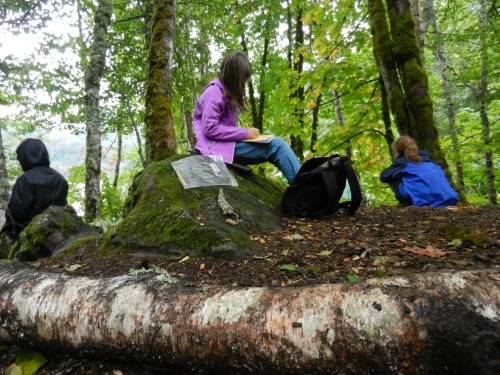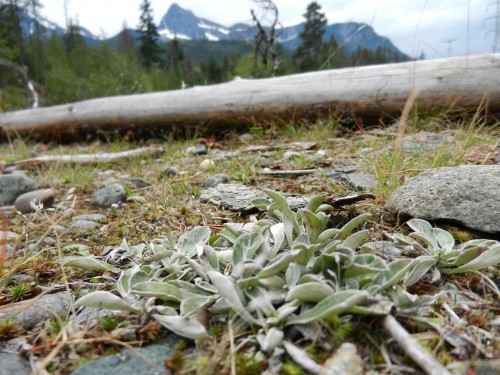Sitting with Nature

It’s the second day of Mountain School and our group, the Flying Squirrels, sits spread out along the Sourdough Creek Trail at the Environmental Learning Center with journals and pencils in hand. The forest is seemingly quiet, Fawn Creek tumbles softly along its path in the background and the occasional douglas squirrel rouses student attention with his yapping alert call. Angelyna is writing tirelessly, attempting to take in all that she’s seeing around her. Ben has his head to the sky, perhaps noticing the wind playing up in the tops of the giant western red cedars. I notice Maxim with his face right up to a lichen, alternating between intense moments of observation and quick strokes of the pencil as he sketches in his journal. The first notes of my wolf howl to round up the students are immediately echoed by nine voices, and promptly followed by nine pairs of feet padding up the trail. “What have you been wondering about?” I ask.
Developing sensory awareness and the desire to observe and learn from the natural world are critical components to the Mountain School experience. Sit spots, like the ones that the Flying Squirrels were practicing, are opportunities for students to be still for a few quiet moments in the woods, engaging all of their senses while taking note of what is going on in the world immediately around them.
Earlier that morning I visited my own ritual place in the forest, my downed douglas fir that serves as the “sit” to my “spot” up in Buster Brown meadow above the Environmental Learning Center campus. Pyramid Peak is the focus of my panorama, and the longer I stare at its bold, glacially carved rock faces, the easier it becomes for me to let my mind wander and to slowly refocus my attention on the detailed world at my feet: the mosses, the middens, the marching ants excavating and shredding up my perch on the dead douglas fir. Why did this tree fall? might be the first in a series of questions I could ask about this small spot in the world. That douglas squirrel calling out from beneath the bracken fern at the edge of the meadow, what is he so worried about?
Observation begins with slowing down, with deciding to consciously watch the world right outside of you. We sit, we wait, and we watch. And then at some point we begin to ask questions, inquiry is the natural progression of observation. We sketch and we sketch until that moment when we realize that all that we see around us infinitely outweighs all that we know within us, and in this way we become curious and inquisitive about our environment. When I return to my sit spot each morning, I know that I will never run out of questions to consider, never not find something worth looking into that might better help to shape my understanding of my home in the North Cascades.
 Wooly pussytoes, Antennaria lanata, and the world around my feet. Pyramid Peak as the backdrop.
Wooly pussytoes, Antennaria lanata, and the world around my feet. Pyramid Peak as the backdrop.
When students are introduced to sit spots at Mountain School, one hope is that maybe the quiet of still time in the woods will allow them to hear a few questions of their own, whether drawing, writing, or watching, time spent sitting on the forest floor becomes a student’s own teaching tool. At first some students may find it tedious, thinking about just another tree to stop and stare at along the trail. But maybe next time, or the time after that, the sitting will begin to sit with them and eventually they will begin to enjoy and to hear all of the questions that come out of the quiet act of being alone in nature.


Kiira I love reading this. It made me feel so peaceful and yet so aware of what a wonderful environment you have found yourself in. Keep writing and I promise to check in regularly.
Wise words Kiira. The sitting brings important questions and even more important answers.